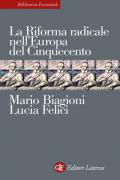La Riforma radicale nell'Europa del Cinquecento

What is Radical Reform? The expression appeared in 1957 by the historian G. H. Williams, who defined it in relation to the Protestant churches of the Magisterium. This complex movement arose within the Reformation, sharing its principles and instances of religious renewal. However, it offered different orientations and outcomes, which proved to be fundamental to the development in the modern world of values such as freedom, tolerance, individual dignity, secularisation of the state and society. The absence of a doctrinaire corpus and a homogeneous organization enabled the radical Reformation to bring out individual, communitarian and sectarian paths, often faced with persecution and clandestinity. The religious conceptions of these men gave rise to spiritualism, Anabaptism and antitrinitarianism. This volume presents a reconstruction of the history of the movement and an update of the historiographic debate.